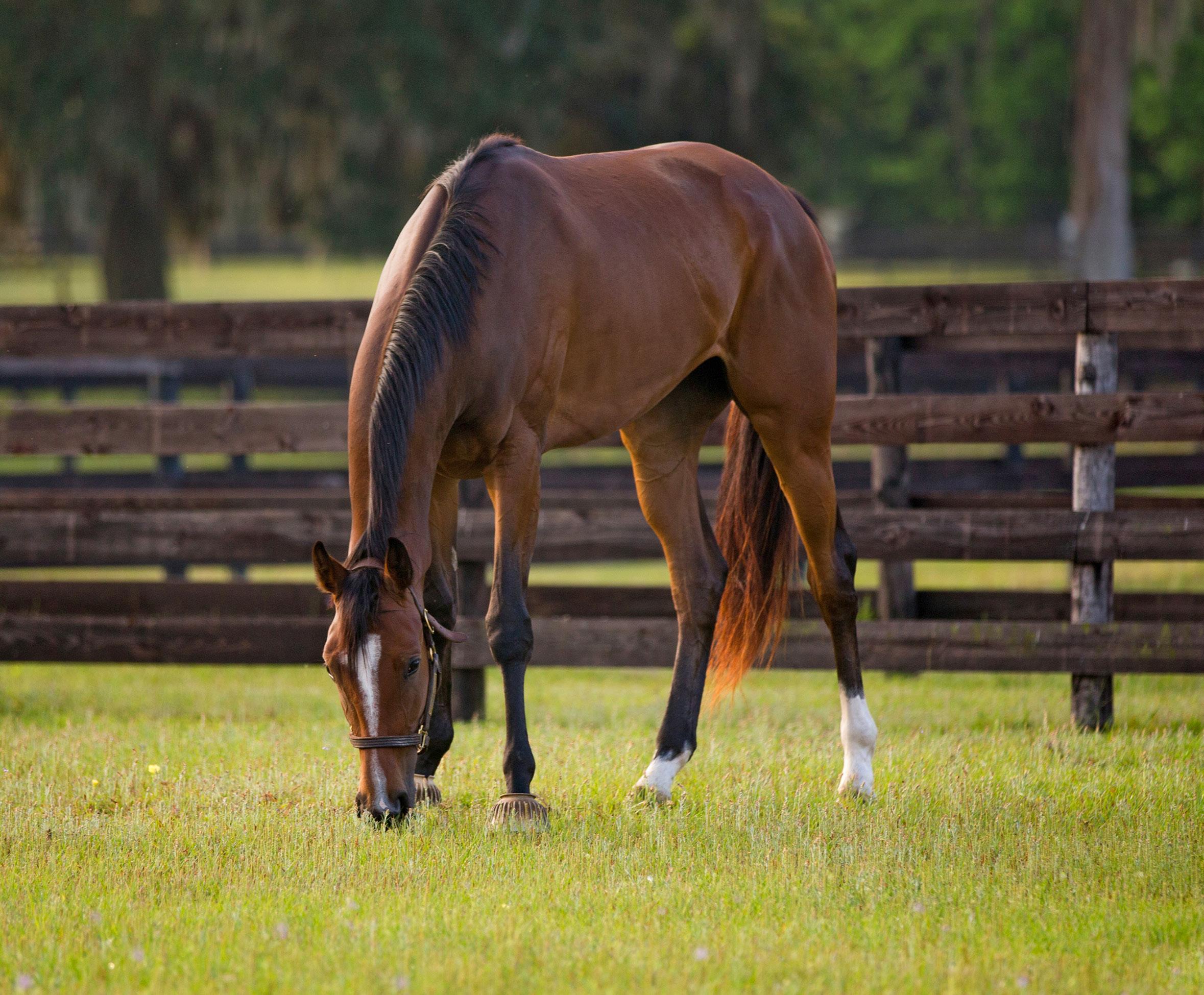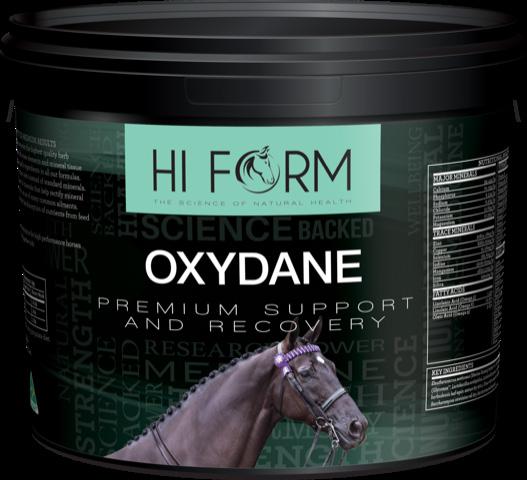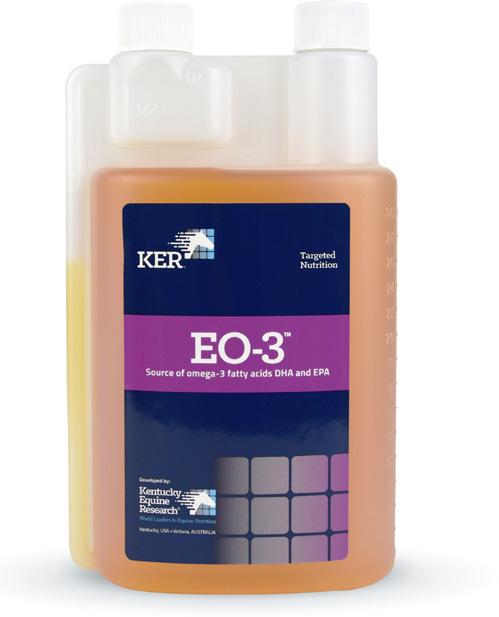
5 minute read
Ask an Expert: Rebecca Ham
ASK AN EXPERT
Rebecca Ham: Equine nutritionist
Meet our expert REBECCA HAM, who has a degree in Equine Science and is a member of the Kentucky Equine Research team. We asked for her advice on keeping condition on Thoroughbreds.
Quality pasture helps to meet a horse’s protein requirements (Image courtesy of Kentucky Equine Research).
How much protein is required?
The protein requirement for horses depends on life stage and workload. The current National Research Council recommendations for protein intake in a 500kg adult horse in work is 540g per day, for horses in light work 699g per day, and those in moderate work 768g per day. Quality pasture, hay and well formulated feeds or balancers are usually adequate in meeting these requirements.
When it comes to protein, quality is far more important than quantity. A higher quality protein more effectively delivers the essential amino acids required by the horse that cannot be made in the body. A high-quality protein source can be fed in relatively small amounts. Feeding a lower quality protein at a
1

4

HORSE HEALTH
All you need to keep your unicorn in great shape
2
5 3

6

1. KER Equi-Jewel® is a scientifically formulated high-fat, lowstarch, and cool-energy conditioner – from $56.95. 2. AXIS Oral Broad Spectrum Worm Paste for horses up to 700kg – from $17.95. 3. HI-FORM Oxydane, daily nutritional support and recovery assistance for high performance horses – from $89.97. 4. MCDOWELLS Equisite, mane to tail shine, formulated with herbs traditionally known to improve skin, coat and hair condition – from $90.95. 5. MISSY'S BUCKET Gut-Plus Nutritional Supplement, one supplement, all bases covered. The ultimate in nutritional support – RRP Bucket $190.50, Refill Bag $180.50 6. BANANA FEEDS AUSTRALIA B-Complete, a 100% natural equine supplement for improving the gut health of horses using green bananas – from $80.00. 7. KER EO-3, a rich source of the long-chain omega-3 fatty acids DHA and EPA in a palatable liquid form – from $79.95. 8. POTTIE'S Cough Mixture, a palatable syrup to relieve coughing in horses – 500ml $42.95. Stockist info page 112.
7 8



higher rate is not going to meet the horse’s requirements for these essential amino acids. Optimal protein in a horse’s diet helps to build and maintain muscle, which is important for supporting athleticism and performance.
Does excess protein make TBs ‘fizzy’?
It is a common misconception that high protein diets contribute to more ‘fizzy’ type behaviour. This is not the case. It’s usually linked to other energy sources in the diet like carbohydrates, which have a greater influence on glycaemic response post feeding. Excess protein intake can result in the horse needing to drink more to excrete the urea and nitrogen that are broken down as part of protein metabolism.
What’s the best cool feed for TBs that improves weight and also helps to keep condition on?
Fibre, fibre, fibre! Fibre intake needs to be at least 1.5% of body weight per day on a dry matter basis. When needing the extra calories for weight gain, this can be offered ad lib if appropriate. When the horse has a healthy microbiome in their hindgut, they are very effective at deriving energy from the fibre provided in pasture, hay, chaff, haylage or other highly digestible supers. As the microbes break down this fibre, they produce B group vitamins, which have been linked to undesirable behaviour if these levels become low. Essentially, good gut health can assist in good behaviour as well as improved feed utilisation.
Selecting super fibre sources such as beet pulp and soy hulls can be valuable here as they are more digestible and can contain more calories than other fibre sources like hay. Additionally, in winter the fermentation process that fibre undergoes during metabolism produces heat, helping to keep the horse warm.
In terms of feeds other than fibre, using a high calorie ingredient such as stabilised rice bran can be useful in increasing the calorie density of the ration without substantially increasing the volume of the meal. Keeping meal sizes small is critical as the horse only has a small stomach, and reducing the size of the feed will help to improve utilisation as it goes through the gastrointestinal tract.
What feeds should you avoid?
If you have a particularly ‘fizzy’ Thoroughbred, basing the diet on fat and fibre is a great way to go. Getting a tested, low non-structural carbohydrate hay is a good option, or soaking it helps to reduce the non-structural carbohydrate if you are unsure of its analysis. Selecting the right type of fibre is important as well and there are lots of options! Typically, lucerne hay may have a higher digestible energy content and lower non-structural carbohydrate content than a grass hay. When looking for a commercial feed, selecting one with a lower non-structural carbohydrate content is a good idea. But make sure you also take into account the feeding rate. Even if this figure is low, if you are feeding 4kg per day, it may add up to more than if you have a slightly higher figure but are only feeding 2kg per day.
If you are experiencing problems with getting weight on your horse, have a ‘fizzy’ horse or are concerned about gastrointestinal health, it is a good idea to speak with a reputable, qualified equine nutritionist as they can look at all aspects of your horse’s feeding and management program to come up with an individual solution for you and your horse.
If you would like to speak to a member of the nutrition team at Kentucky Equine Research, you can get in contact on 1800 772 198 or advice@ker.com












